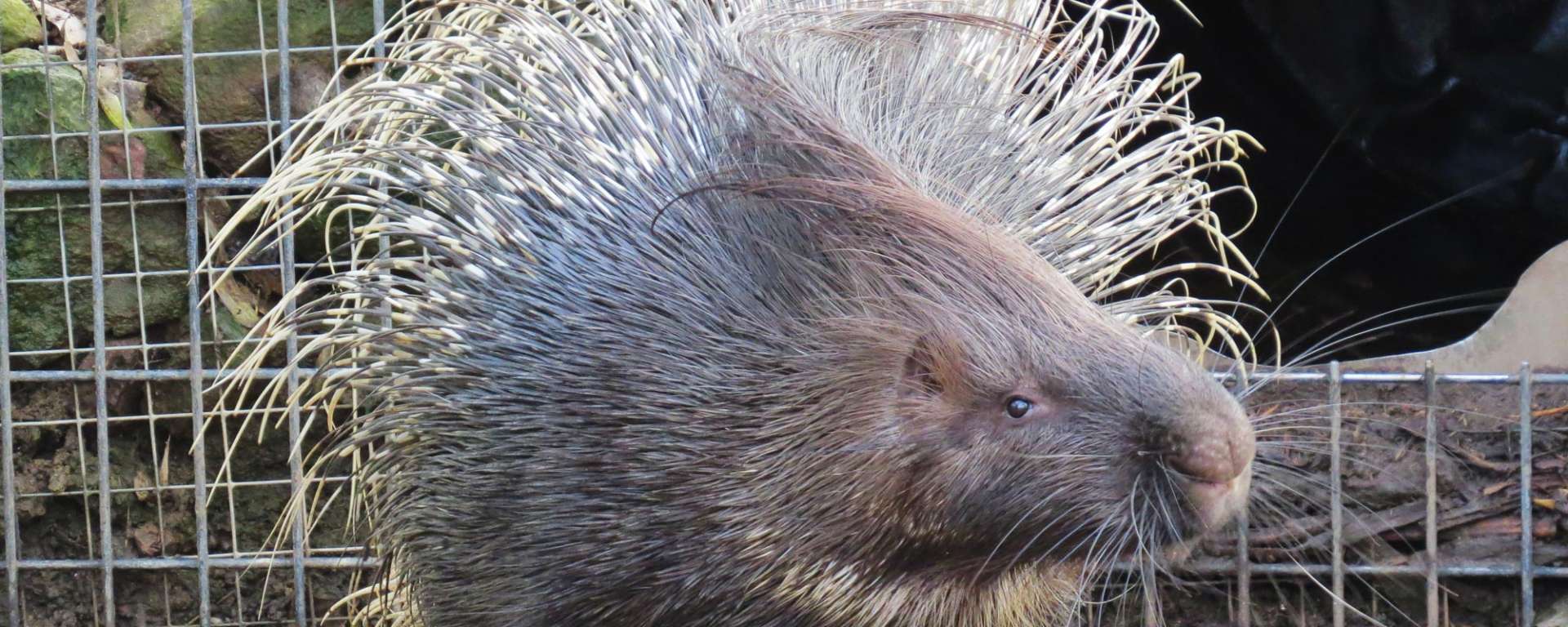Description
Crested porcupines have black and white stripped bristles and hollow quills covering their bodies. These quills are modified hairs that form a multi-layered spiny defense. Their tails are covered with shorter white quills, while their neck, shoulders and rears are covered with a crest of long quills up to 5-20 in (15-50 cm). Crested porcupines have broad feet and hands with long claws that are used for burrowing. Their small eyes are indicative of a nocturnal lifestyle.
Classification
- Class
- Mammalia
- Order
- Rodentia
- Family
- Hystricidae
- Genus
- Hystrix
- Species
- H. indica
- Conservation Status
- Least Concern
Key Facts
- Height
- 27-35 in (~70-90 cm)
- Weight
- 24-60 lb (~11-27 kg)
The IUCN Red List describes Hystrix indica as a species of Least Concern with a widespread population and no major threats.
Social Life
Crested porcupines are nocturnal and dig burrows or inhabit caves. They are Old World porcupines and thus live in family groups consisting of a monogamous pair and multiple generations of their offspring. When threatened the porcupine will raise its quills and rattles the hollow spines on its tail. If this warning is not heeded they will then run backwards and stick the quills into the attacker. This can lead to severe injury and a subsequent infection caused by bacteria on the quills.
Habitat and Range
Crested porcupines are found in a variety of habitats. They usually favor rocky hillsides, but can also be found in tropical and temperate scrublands, grasslands, deserts, forests and throughout the Himalayan Mountains. Crested porcupines are found throughout southeast and central Asia and in parts of the Middle East. Their wide range includes but is not limited to: India, Nepal, Bhutan, Bangladesh, Sri Lanka, Turkey, Afghanistan, Pakistan, China, Israel, Iran, Iraq, Yemen and Saudi Arabia.
Diet
Crested porcupines are herbivores that eat berries, fruits, roots, grains and bulbs. They will occasionally consume insects and carrion and have been known to chew on bones to provide calcium and to file their teeth.
Lifespan
Captive crested porcupines may live up to 27 years, while wild porcupines may live up to 15 years.
Predators
Main predators of porcupines include tigers and leopards. Since these rodents are well armored there are recorded fatalities of these big cats that had quills stuck into them.
Reproduction
Sexual maturity: Male: 8-18 months, Female: 9-16 months
Mating Season: November to December
Birth Season: February to March
Gestation: 112-118 days
No. of Young: 1-4, usually 2
- Information
-
Description
Crested porcupines have black and white stripped bristles and hollow quills covering their bodies. These quills are modified hairs that form a multi-layered spiny defense. Their tails are covered with shorter white quills, while their neck, shoulders and rears are covered with a crest of long quills up to 5-20 in (15-50 cm). Crested porcupines have broad feet and hands with long claws that are used for burrowing. Their small eyes are indicative of a nocturnal lifestyle.
Classification
- Class
- Mammalia
- Order
- Rodentia
- Family
- Hystricidae
- Genus
- Hystrix
- Species
- H. indica
- Conservation Status
- Least Concern
Key Facts
- Height
- 27-35 in (~70-90 cm)
- Weight
- 24-60 lb (~11-27 kg)
- Conservation
The IUCN Red List describes Hystrix indica as a species of Least Concern with a widespread population and no major threats.
- Lifestyle
Social Life
Crested porcupines are nocturnal and dig burrows or inhabit caves. They are Old World porcupines and thus live in family groups consisting of a monogamous pair and multiple generations of their offspring. When threatened the porcupine will raise its quills and rattles the hollow spines on its tail. If this warning is not heeded they will then run backwards and stick the quills into the attacker. This can lead to severe injury and a subsequent infection caused by bacteria on the quills.Habitat and Range
Crested porcupines are found in a variety of habitats. They usually favor rocky hillsides, but can also be found in tropical and temperate scrublands, grasslands, deserts, forests and throughout the Himalayan Mountains. Crested porcupines are found throughout southeast and central Asia and in parts of the Middle East. Their wide range includes but is not limited to: India, Nepal, Bhutan, Bangladesh, Sri Lanka, Turkey, Afghanistan, Pakistan, China, Israel, Iran, Iraq, Yemen and Saudi Arabia.Diet
Crested porcupines are herbivores that eat berries, fruits, roots, grains and bulbs. They will occasionally consume insects and carrion and have been known to chew on bones to provide calcium and to file their teeth.Lifespan
Captive crested porcupines may live up to 27 years, while wild porcupines may live up to 15 years.Predators
Main predators of porcupines include tigers and leopards. Since these rodents are well armored there are recorded fatalities of these big cats that had quills stuck into them.Reproduction
Sexual maturity: Male: 8-18 months, Female: 9-16 months
Mating Season: November to December
Birth Season: February to March
Gestation: 112-118 days
No. of Young: 1-4, usually 2

